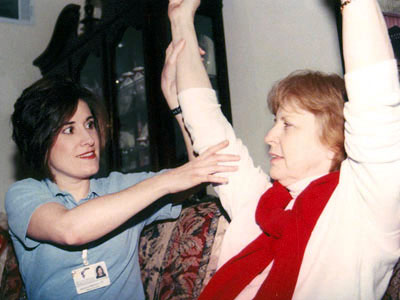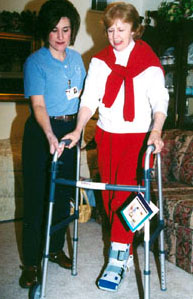JACKSON, Miss.—One minute Geri Story of Jackson was zipping down her condo stairs, happily in the midst of multi-tasking. And the next she was crawling across her kitchen floor, trying desperately to reach a phone and dial 911.
Story had become the victim of what has been called the most prevalent medical problem facing senior citizens – fall-related injuries. The National Safety Council reports that 9,000 people in the United States died from falls in 2001, and four out of five of the victims were over age 65. In Mississippi, falls claimed the lives of 141 senior citizens in 2001.
As a result of her fall, Story broke three bones in her left leg and “tore everything that could be torn” in her right ankle. And even though she now lives with a metal rod and screws in her left leg, she realizes she was more fortunate than many.
“Once an older person falls, it can lead to a downward spiral,” said Sabrina Sherrill, director of Rehabilitation Surgery for Methodist Rehabilitation Center in Jackson. “When my mother fell, it was the beginning of the end.”
The 340,000 people who break their hips each year seem to suffer the worst fates. A quarter die within a year, and 40 percent wind up in nursing homes. “That’s why it’s really important to do all you can to avoid falls,” Sherrill said.
Since 60 percent of falls occur in the home, fall prevention should start with a critical look at your surroundings, said Kim McGaugh, therapy manager for Rehabilitation Surgery at Methodist Rehab.
Common hazards include slippery throw rugs, appliance cords that stretch across pathways and wobbly furniture. “Clutter is another big issue,” McGaugh said. “I’ve been to several houses where there was so much clutter around that it was hard to walk. And people need to be careful around their pets. I know of several falls that happened because someone tripped over a dog or cat.”
To reduce the risk of falls, McGaugh recommends adding safety improvements, such as hand rails for stairways, grab bars for the shower stall and brighter lighting.
Such modifications are particularly crucial for stroke survivors, who may suffer from residual dizziness or balance problems, said Peter Fayard, stroke therapy manager at Methodist Rehab. “A recent article in “Stroke: Journal of the American Heart Association” reported that about 40 percent of stroke survivors suffer serious falls within a year of their stroke,” Fayard said. “Research also indicates that stroke survivors are four times more likely than others to suffer a hip fracture.”
Sherrill said physical ailments contribute to many falls, and can range from poor vision related to cataracts and glaucoma to gait and balance disorders linked to Parkinson’s. Cardiovascular diseases also can cause fainting, a common predecessor to falls. Plus, disorders that affect the legs and feet – arthritis, muscle weakness and nerve damage – can affect coordination.
Research has shown that Alzheimer’s disease or other forms of dementia also can increase a person’s risk for falls due to impaired brain cells and structures that control coordination, movement, perception and vision. “Certainly, not all people who fall have Alzheimer’s disease,” said Dr. Samuel T. Gontkovsky, a clinical neuropsychologist at Methodist Rehab. “But if a fall happens in conjunction with common signs of dementia, such as frequent forgetfulness, then a medical examination should be considered to rule out a central nervous system disorder.”
Sherrill said another less obvious contributor to falls is bladder conditions. In their haste to get to the bathroom during the night, some senior citizens get dizzy from standing up too quickly, while others trip in the dark because they didn’t take time to turn on a light.
Medications that affect balance or perception, such as over-the-counter antihistamines or diuretics, sedatives or medications for hypertension or psychological problems, also put seniors at a heightened risk for falls, said Sandy Culver, pharmacy director at Methodist Rehab.
“That’s not a reason to stop taking the medicines,” cautions Culver. “But if you’re aware of the problem, you can at least be more cautious when you’re taking these prescriptions. And if you are experiencing dizziness, you can talk with your physician about finding another medication without that side effect.”
In the case of hip fractures, the culprit often is osteoporosis, a disease that causes a gradual loss of bone tissue or bone density. According to the National Institutes of Health, more than 90 percent of hip fractures are associated with osteoporosis. To reduce this fracture risk, NIH recommends senior citizens take adequate amounts of calcium and vitamin D, exercise several times a week and ask their physicians about medications that slow bone loss. Seniors also are urged to get a bone density test.
While Story’s physician suspected she might have brittle bones, Story knew better. “One of my sisters is 81 and has fallen several times because of fragile bones,” she said. “That is why I already had my bone density checked and it was fine. When I fell, I was just distracted. I was zipping down the stairs and my left foot hit the next to the last step and slipped off.”
Therapy has helped Story improve her strength and balance, and she’s grateful that she’ll be able to regain her independence and return to her job as a program assistant at the Veteran’s Administration Medical Center. “I love helping people, but I have a hard time accepting it for myself,” she said.
That’s true of many senior citizens, and one reason a fall’s aftermath can be so devastating, Sherrill said. “At Methodist Rehab, we strive to get people back in their home environment after a fall. But for a lot of the patients, we have to tell their families that they can’t go back to living alone,” she said. “That is hard for sons and daughters. Their mom or dad was home taking care of themselves and a week later, bang, they can’t do any of that. That’s why it’s critical that the whole family focus on fall prevention.”
FAST FACTS ON ELDERLY FALLS
The Problem
- Falls are the No. 1 cause of fatal and non-fatal injuries for people over age 65. One out of three people in this age group fall each year.
- The National Safety Council Reports that 9,000 people in the U.S. died from falls in 2001, and four out of five victims were over age 65.
- In Mississippi, falls claimed the lives of 141 people over age 65 in 2001.
- Of the 340,000 people who break their hips each year, a quarter die within a year and 40 percent of patients 65 and older wind up in nursing homes.
- Because the U.S. population is aging, the number of hip fractures could reach 650,000 by 2050.
Common Causes of Falls
- Environmental Concerns – Sixty percent of falls occur in the home. Common hazards include slippery throw rugs, appliance cords stretched across pathways, poor lighting and clutter on the floor.
- Physical conditions – Declining balance, weakened muscles, deteriorating vision and slowed reaction times all contribute to falls. Diseases such as Alzheimer’s and dementia may affect movement and perception, and disorders affecting the legs and feet may affect coordination. Cardiovascular diseases may cause fainting, a common predecessor to falls. Gait and balance disorders, such as Parkinson’s, interfere with walking. Bladder conditions also play a role, because many fall in their hurry to get to the bathroom at night.
- Medications – Over-the-counter antihistamines, as well as diuretics, sedatives or prescriptions for hypertension or psychological problems, may cause dizziness.
- Osteoporosis – More than 90 percent of hip fractures are associated with osteoporosis, a disease that causes gradual loss of bone tissue or bone density.
Fall Prevention Strategies
- Install full-length handrails on both sides of stairway and grab bars on the walls around the bathtub.
- Improve lighting in the home, particularly along pathways and at the bottom and top of stairs.
- Secure loose area rugs and runners with double-faced tape, tacks, or slip-resistant backing.
- Keep the floor clear of clutter, and remove obstructions such as low furniture, magazine racks, footrests and plants from pathway.
- To reduce the risk of osteoporosis, take adequate amounts of calcium and vitamin D, exercise several times a week and ask your physician about medications that slow bone loss.
For more information:
Don't fall for just anything! | The Clarion-Ledger


